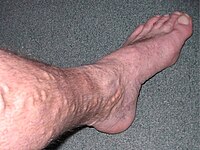
Photo from wikipedia
We read with interest the article ‘Peri-operative management of ophthalmic patients on anti-thrombotic agents: a literature review’ by Makuloluwa et al. [1]. The article states that expert opinion is to… Click to show full abstract
We read with interest the article ‘Peri-operative management of ophthalmic patients on anti-thrombotic agents: a literature review’ by Makuloluwa et al. [1]. The article states that expert opinion is to stop anti-thrombotic medication (antiplatelet and anticoagulants) in patients undergoing lacrimal, deep orbital surgery or eyelid procedures as these are high risk for sight threatening haemorrhagic complications. We report the findings of our prospective audit of patients on anti-thrombotics undergoing oculoplastic, lacrimal and orbital surgery at a single centre (Kings College London, UK) between September 2018 and September 2019. All procedures used cold steel techniques, diathermy with no post-operative padding. The incidence of postoperative haematoma formation was calculated using electronic records (Medisoft, Leeds UK) and cross-checked using postoperative photographs. A total of 118 procedures were carried out including eyelid (n= 111; 16 posterior approach for ptosis [2]), lacrimal (n= 5) and orbital (n= 2) on patients on antithrombotics. Thirty-five procedures were on patients using anticoagulants (20 Warfarin, 4 Rivaroxaban or 11 Apixaban) and 71 on antiplatelet (14 Clopidogrel and/or 68 Aspirin) therapy alone. Twelve procedures were on patients taking both anticoagulant and antiplatelet medication. The rate of post-operative haematoma formation in this study was 3/118 (2.5%): two cases were in patients taking aspirin and one on warfarin. There was neither loss in visual acuity nor repeat surgery. The haematomas resolved with time. We conclude that continuation of anti-thrombotics in oculoplastic surgery is safe with a 2.5% risk of haematoma formation with no visual loss, even in procedures posterior to the orbital septum. A large proportion of patients had atrial fibrillation, which carrries up to a fivefold increase in the risk of stroke (23.5% aged 80–89 years) [3, 4]. A lack of padding post-operatively may sound counterintuitive as pressure does stem bleeding: traditional teaching would recommend padding all patients with removal the following day. However, avoiding padding allows for monitoring of visual acuity and maintains binocular vision, especially in elderly patients that may have poor visual acuity in the nonoperated eye. A possible alternative is to pad for an hour immediately post-operatively. Good surgical haemostasis, use of spreading dissection and reverse Trendelenburg may also help prevent haematoma formation.
Journal Title: Eye
Year Published: 2020
Link to full text (if available)
Share on Social Media: Sign Up to like & get
recommendations!